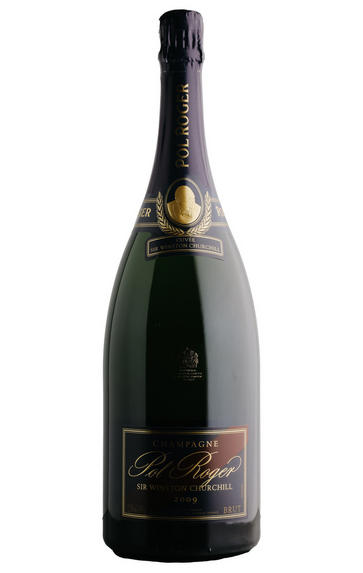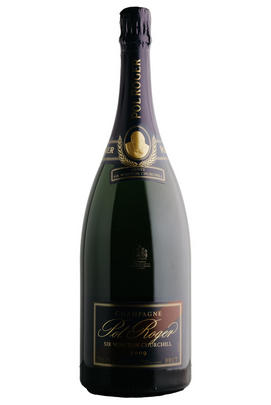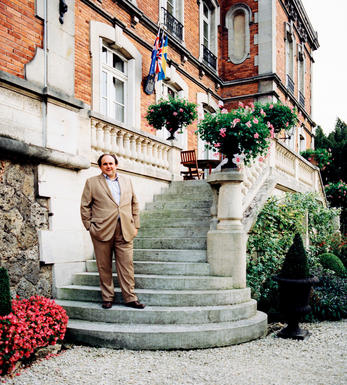
2009 Champagne Pol Roger, Sir Winston Churchill, Brut

Critics reviews
The Pinot Noir dominated Winston Churchill is rather steroidal in 2009; aromas of apricot, apple skin, and cocoa are found on the nose. The palate feels mature; honeyed fig and yellow plum aromas are dusted with a toasty chocolate spice. Full-bodied and relatively complex, I'd drink this powerful brut(e) over the next few years.
Drink 2023 - 2026
Jasper Morris MW, InsideBurgundy.com (September 2023)
The 2009 Brut Cuvée Sir Winston Churchill is a heady, explosive Champagne. Ample and deep, the Churchill is so expressive today. Apricot, tangerine oil, mint, baked apple tart and spice all flesh out. I would give the 2009 at least a year or two in bottle, as it is a bit tight at this stage. Even so, time in the glass brings out a feeling of raw power that is impossible to miss.
Drink 2022 - 2039
Antonio Galloni, Vinous.com (November 2020)
A few years after its disgorgement now, the 2009 Cuvée Sir Winston Churchill has digested its dosage and is beginning to offer up real complexity. Mingling aromas of freshly baked bread, honeycomb, crisp peach, pear and subtle hints of dried fruits, it's medium to full-bodied, sapid and vinous, with bright acids, a pearly mousse and a long, saline finish. Exhibiting more structure than was apparent on release, this has always been a very approachable Churchill, yet it is really benefiting from age.
One of the casualties of COVID-19 was a planned vertical tasting of Pol Roger's Cuvée Winston Churchill, which would have provided some additional context for the latest iteration of this textural, gastronomic, Pinot Noir-dominant bottling. Since that project is deferred to later this year, I've opted to publish my review of the newly released 2009 in the meantime. While the 2009 is structurally more open than the concentrated, tightly wound 2008, it's also still quite youthfully primary, and I would encourage readers to resist its deceptive accessibility right now and wait at least a few years for more complexity and aromatic range to emerge. That said, I can't claim that it was a hardship, even at this early stage, to work through several bottles of the 2009 for this report.
Drink 2022 - 2040
William Kelley, Wine Advocate (March 2023)
Immediate complexity on the nose – salted bread, green apple, a hint of butter. Sweet spice too, and a mushroom earthiness that shows the age. Rich and full on the palate, with superb concentration and persistence, leaving lots of umami/soy complexity on the finish. Is it Burgundian? Certainly vinous, and there is both marine minerality and savoury fruit, but in a different guise to Burgundy. Wonderfully expressive to drink now, but has a good decade of ageability if not more.
Drink 2020 - 2030
Richard Hemming MW, JancisRobinson.com (November 2020)
Bright and lustrous with playful bubbles and a soft mousse, the wine is immediately beguiling, seductive and more approachable and charming than its immediate forebear (2008). The nose waltzes through the Viennese patisserie and then into the orchard, where red apples rejoin citric rigour and draw the taster in. The ripeness of the vintage translates into a rich, creamy texture, with energy and warmth all underwritten by a dominant but not overly domineering Pinot Noir, its savoury notes destined to take control after this first effervescent flush of youth. The finish is pure and long. A forward and confident SWC, and one to enjoy in relative youth.
Drink 2020 - 2035
Simon Field, Decanter.com (March 2020)
About this WINE

Pol Roger
Pol Roger is perhaps best known as Winston Churchill's favourite Champagne. The house remains family-owned and has a reputation for producing champagnes of finesse and elegance which age very well. Pol Roger Brut Rèserve Non-Vintage, made from equal parts of Chardonnay, Pinot Noir and Pinot Meunier, is consistently one of the very best on the market, largely due to the high proportion of aged reserve wines in the blend.
Pol Roger vintage wines, made from at least 60% Pinot Noir and up to 40% Chardonnay, are soft and fruit-driven in youth but, after ten years or so, develop great complexity and finesse. The Cuvée Sir Winston Churchill, launched in 1984 and made from a secret blend, is a Champagne of exquisite finesse and balance and one that rivals the very best of the region.

Brut Champagne
Brut denotes a dry style of Champagne (less than 15 grams per litre). Most Champagne is non-vintage, produced from a blend from different years. The non-vintage blend is always based predominately on wines made from the current harvest, enriched with aged wines (their proportion and age varies by brand) from earlier harvests, which impart an additional level of complexity to the end wine. Champagnes from a single vintage are labelled with the year reference and with the description Millésimé.
Non-vintage Champagnes can improve with short-term ageing (typically two to three years), while vintages can develop over much longer periods (five to 30 years). The most exquisite and often top-priced expression of a house’s style is referred to as Prestige Cuvée. Famous examples include Louis Roederer's Cristal, Moët & Chandon's Dom Pérignon, and Pol Roger's Cuvée Sir Winston Churchill.
Recommended Producers : Krug, Billecart Salmon, Pol Roger, Bollinger, Salon, Gosset, Pierre Péters, Ruinart

Champagne blend
Which grapes are included in the blend, and their proportion, is one of the key factors determining the style of most Champagnes. Three grapes are used - Pinot Noir, Chardonnay and Pinot Meunier.
26% of vineyards in Champagne are planted with Chardonnay and it performs best on the Côtes des Blancs and on the chalk slopes south of Epernay. It is relatively simple to grow, although it buds early and thus is susceptible to spring frosts. It produces lighter, fresher wines than those from Burgundy and gives finesse, fruit and elegance to the final blend. It is the sole grape in Blancs de Blancs, which are some of the richest long-lived Champagnes produced.
Pinot Noir accounts for nearly 40% of the plantings in Champagne and lies at the heart of most blends - it gives Champagne its body, structure, strength and grip. It is planted across Champagne and particularly so in the southern Aube district.
The final component is Pinot Meunier and this constitutes nearly 35% of the plantings. Its durability and resistance to spring frosts make the Marne Valley, a notorious frost pocket, its natural home. It ripens well in poor years and produces a soft, fruity style of wine that is ideal for blending with the more assertive flavours of Pinot Noir. Producers allege that Pinot Meunier lacks ageing potential, but this does not deter Krug from including around 15% of it in their final blends.


Buying options
Add to wishlist
Description
The Pinot Noir dominated Winston Churchill is rather steroidal in 2009; aromas of apricot, apple skin, and cocoa are found on the nose. The palate feels mature; honeyed fig and yellow plum aromas are dusted with a toasty chocolate spice. Full-bodied and relatively complex, I'd drink this powerful brut(e) over the next few years.
Drink 2023 - 2026
Jasper Morris MW, InsideBurgundy.com (September 2023)
wine at a glance
Delivery and quality guarantee